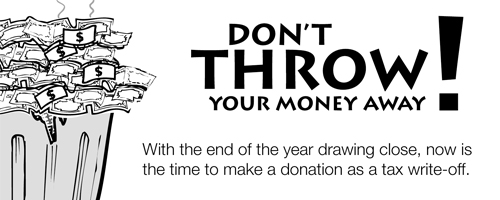
1. There is no substitute for good professional advice. Individuals are well-advised to consult with tax and financial planning professionals between now and year-end. Conversations with either your estate planning attorneys or CPAs are essential.
And the discussion should also include your financial planner or broker as well as a philanthropic advisor such as Foundation for Planned Giving. Decisions can be made now and implemented when most beneficial (after Congress acts or fails to act and before year-end).
2. Run and re-run the numbers under different scenarios. The wild card this year is determining what the income (and estate and gift) tax rates will be for 2010 and 2011. Alternative scenarios will be necessary and adjustments in both projections and resultant planning strategies should be discussed early to allow time for change where necessary.
3. Traditional tax planning is probably not the only answer. This is especially true if individual tax rates rise in 2011 and in future years. As Community went to press, Congress was working on a tax compromise for 2011 that would keep taxes from rising, among other things. At press time, it looks like this initiative will pass. If Congress fails to act by year-end, income tax rates for all taxpayers would increase. In addition, there are over 50 other individual income tax provisions in the tax code, some of which would have the effect of increasing individual taxes for many. If the “phase-out” to itemized deductions, including the charitable contribution deduction, is reinstated in 2011, some donors might want to accelerate some charitable gifts before year-end 2010. But if an individual’s tax rate will be much higher in 2011, it may be preferable to defer a charitable gift until January.
4. Accelerate income to 2010. If tax and financial planners conclude that the best strategy is to accelerate income into 2010, they may suggest certain “one-time-only” strategies such as accelerating receipt of bonus payments traditionally paid in January or recognizing gains from certain capital gain assets from the sale of stocks and securities.
5. Those with primarily portfolio income really need to pay attention. Families with income generated primarily from dividends, capital gains and other investment income should pay close attention to the year-end tax debate. The effective tax rate on significant dividend and capital gains income could more than double from 2010 to 2011, so income acceleration techniques to maximize potential savings this year-end may be most appropriate.
6. Take advantage of market gains, if there are any. With the tax rate on capital gains almost certainly set to increase as of January 1, 2011, tax and financial planners may recommend selling stocks and bonds that have appreciated in value. Bottom line: review your entire portfolio when considering capital asset planning.
7. This could be the year for a Roth IRA conversion. There has been much written about converting traditional IRAs to Roth IRAs in 2010 as there is no income limit this year on who can qualify for this transaction. As with other income and estate tax planning, it is essential to run the numbers to see if this strategy makes sense. A further point to consider is that charitable giving can offset some of the additional taxes that will be generated by the Roth IRA conversion. Making significant charitable contributions before the end of 2010 may be a tax-efficient strategy, especially for those who have sufficient assets to pay the Roth IRA conversion and who will consider making what could be a larger than normal charitable donation this year.
8. Don’t forget basic estate planning, even in times of uncertainty. The basics, such as taking advantage of the annual gift tax exclusion amount of $13,000 per donee ($26,000 where a spouse joins the gift) and a variety of other estate planning techniques remain very attractive in the current low-interest rate environment including charitable lead annuity trusts. Again, this is an area where JCL professionals should be part of the conversation with estate and financial planners.
9. Don’t forget about the alternative minimum tax. For many middle and high-income taxpayers, the alternative minimum tax is an additional factor in tax planning scenarios, often requiring strategies that differ from those for the regular income tax. The AMT may be less of a factor in 2011 and future years if individual income tax rates increase.
10. Start the conversation with advisors as soon as possible. Use the next two weeks as a time to sit down with trusted advisors to review both short- and long-term charitable giving strategies and objectives. From a tax perspective, 2010 may represent the best time in almost a quarter-century for individuals to address their overall tax, estate and philanthropic portfolios.


